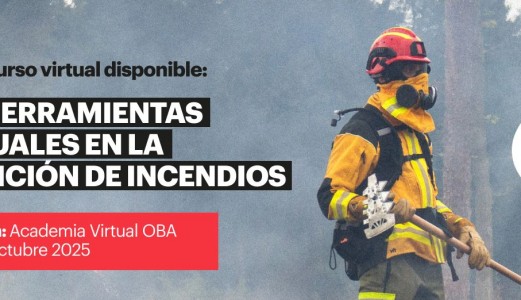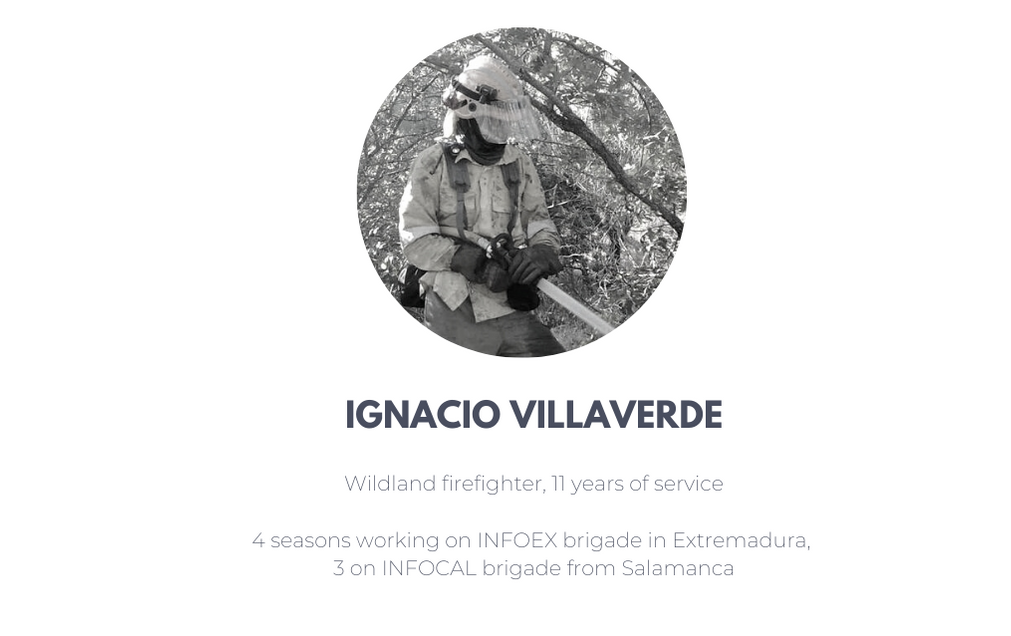
How did you begin in the world of wildland fires?
I was born in Madrid, but at the age of 19, I moved to Puerto de Béjar, my mother’s village in Salamanca, where I currently live. I’ve always had very close ties with the rural world; that’s why I decided to study forest management. At the time I didn’t know I’d end up being a wildland firefighter. That was a decision I made one night while leaving a concert in Extremadura.
…
Besides being a firefighter, I’m a drummer. In 2005, I was playing in a traveling band and, one night, we performed in a village in Caceres, near Lurdes. There was an incredible fire surrounding the entire village. Right in the middle of the performance I began to notice ashes and soon, burning debris falling on the cymbals. It made quite an impact on me. The next morning the fire had gotten closer to the village and upon leaving, we passed through a line of firefighters and flames. I remember I just couldn’t stop looking at the operation. I decided that, if I was going to put my life on the line, I preferred to be on the front line and do so out of my commitment to nature. It was like an epiphany.
You’ve been in active service since 2005. In recent years, there’s been talk of the impact of climate change on wildland fires. Have you noticed any change?
Before we’d go out in search of fires in the hills (except in some cases in very specific areas with a very specific orography where there are pine forests near urban areas like in the region of Caceres. The fires there have always been quite dangerous). Now, you can find fires near urban areas. Those of us who dedicate ourselves to putting out fires know that various factors condition what fire season will be like: the weather, the vegetation and prior history. Prior seasons have a big impact. We’re seeing a chain of intense fires which are more and more proliferous, unruly seasonal rain, hydric stress, an accumulation of fuel... This difference affects the hills and forests. And it’s starting to look like a trend. Huge fires are no longer anecdotal.
Do you think we have the necessary resources to fight these new fires?
There is no adequate operation for certain fires. Human beings cannot go up against crown fires with 20 meter flames. The only thing we can do is take shelter. Squads on the ground can’t even get as close as 50 meters because the radiation would burn them up. And aerial resources also can’t engage in direct attack. Extinction operatives can handle certain situations yet as soon as it hits a certain intensity or behavior, all we can do is follow behind. The fire’s the boss and it moves at its own pace depending on the fuel, orography and weather which it actually creates. There are no resources for fighting sixth generation fires. Extinction is just one leg in the world of wildland fire; prevention and landscape management are things we can do to mitigate the effects.
In August 2019, you sent out a controversial tweet which became viral:
En agosto de 2019 publicaste un tweet polémico que se hizo viral:
Nos llamáis "Héroes" cuando hay un incendio. Pero cuando os hablamos de qué medios de extinción son mas idóneos u os aconsejamos que pidáis gestión forestal antes que "Hidroaviones" y "Nivel 3" resulta que de incendios no tenemos ni idea #HacéosloMirar #IFValleseco
— Ignacio Villaverde (@WildlandFirefig) August 19, 2019
Was that when you decided to use this platform as a way to be heard?
I began my Twitter adventure in 2014. At the time, I was temporarily inoperative yet still felt enormous curiosity for the world of wildland fire. That was when the first Black Wave protests were being organized in Spain as well as other actions to defend this sector’s rights. When I found useful information, I’d share it. But I wasn’t super active in social media and had no specific aim. There was one fire that really hit home in 2016: Ford McMurray in Alberta, Canada. That was the first fire that required mass evacuations (some 60,000 people were displaced). My activity became more phrenetic after that.
This summer, you’ve been closely following the fires in Australia and you were thanked by the Spanish Embassy in Australia (among other institutions) for your informational work. Although it’s true you usually share information on wildland fires occurring all over the world, this summer you became particularly dedicated to the fire crisis in Australia. Why did you become so interested? What was different about those fires?
Queensland, in the north, began to burn in mid-November and the fire started going all the way down to New South Wales. I woke up one day and saw 25 active fires, 10 of which were under emergency alert. Two days later, there were 50 active fires and 35 under a state of alert. The next day, 75. The firefighters in New South Wales had tried to meet with the Prime Minister, Scott Morrison, to warn him of an imminent catastrophe. Their predictions were turning out to be correct yet the message didn’t get through to the country’s government. And I just couldn’t believe it. 35 simultaneous fires under emergency alert! That was in New South Wales, but soon the state of Victoria began burning. Thousand and thousands of hectares. 25 stratospheric fire clouds all at the same time. Huge fires. In mid-December I realized what was happening in Australia was historic; never before in modern times had we seen a wildland fire event of that magnitude in residential areas.
In an interview with Climática in December, you talked about the differences in how fire is managed in Australia and Spain. Here, we work on total suppression, whereas there with the vast amount of remote areas, they’re forced to just watch the fires, let them run their course and only act when residential areas are threatened. Even though our current paradigm is different, might we face a similar situation some day?
Every area has it own unique characteristics. You can’t compare one region with another. The fires they’ve experienced there won’t happen here because Spain isn’t Australia. Its geographic dispersion and extinction model are different than ours as is the way they manage threats. Fires in Australia essentially start in remote areas and prevention is basically through prescribed burning. Because of the drought situation, it hasn’t really been possible to do burning in recent years. This has had serious consequences during fire season. Australians now understand they must change the way in which they relate with nature. That’s something we have in common on the Iberian Peninsula: the voracity of the fires, fires fanned by climate change and the need for a new social model. We need change that’s more longer-term, we need to work the fields more, and get involved in preventive landscape management so fire once again becomes a constructive and not destructive part of our ecosystems.
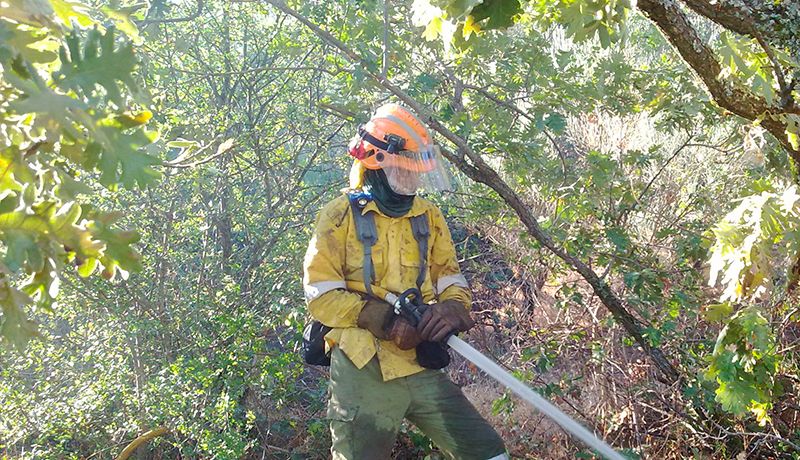
What are some work methods or maneuvers you’ve seen abroad that could or should be applied in Spain (and vice-versa)?
The use of technical fires, like you see in Australia or California, should be encouraged much more on the Iberian Peninsula. The idea is to recover the traditional use of fire (which has been forgotten as we’ve turned into an urbanite society and have begun to view extinction from the total suppression side). Fire is a tool in wildland management.
In Australia, however, there are practically no helitransported units. Even though its orography is quite different from ours, there are areas where it could be very useful. Plus, it’s a society that’s really proud of its volunteer tradition which is hesitant to change; but, they should consider the benefits of professional operatives.
National and international relations among wildland fire professionals should be strengthened for the common good. Ties have been made in the last 15 years since the birth of the Pau Costa Foundation and there has been some very fruitful exchange. Learning about other ways of working is not only enriching, it can be essential to fighting new fires.
What do you expect of the 2020 season in Spain?
We’re seeing a very rainy spring. Summer will arrive with a great deal of pastureland. Given the situation in our hills, we could see a season much like 2018. However, there was no coronavirus in 2018. There’s been a lot less prevention. We’re accumulating hydric stress. There’s more fuel available and even though there’s a really pretty foliage color, really green, the release of moisture could be fast if the temperature suddenly rises which would change the state of the vegetation in a question of days. We’re at the mercy of the weather. If the weather is good and management is prioritized, it may be a rather peaceful season. But, the climate models seem to indicate it’ll be a busy summer.
What is a typical day like for fire-fighting brigades during fire season?
When on call, you spend the whole day glued to the radio and doing reports. They’re 10-hour days. When a warning comes in, you hear how more and more resources are being sent out. You have to really beware of how the fire is behaving. And when the bell rings, all of your senses suddenly awaken. While on the way, you start mentally calculating routes. If you know the area, you go about building and visualizing the ground and spread to get a head start. As you get closer, you start noticing things that help assess the situation: Is the curve of smoke on its side? What color is it? Then, depending on your position (going by helicopter is not the same as traveling in a ground squad or fire truck, each one has its own dynamic), you’ll have to do one thing or another. Some fires can be put out in just 2 hours. Others take weeks. The adrenaline rush gets you to tolerate things you wouldn’t in a normal situation, but you have to be able to control it. On the ground, you really find out what kind of person you are. You can have all sorts of theoretical knowledge, but when you see yourself just 200 meters from a 10-meter high crown fire coming right at you and you have to take shelter, you’re human, you get scared. If you let yourself get carried away by panic, it’ll be bad. You have to be level-headed enough to dominate that instinct and think about what you can do based on your experience and knowledge. All that has to come from within.
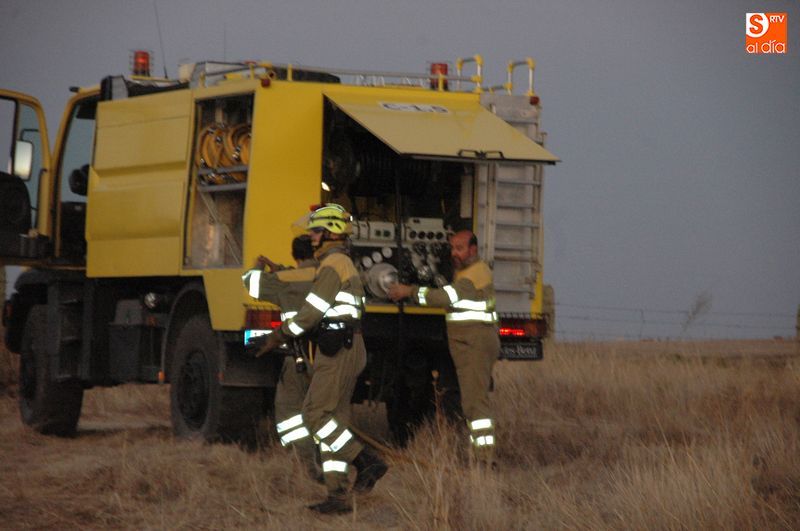
What is the role of strategy and teamwork?
It’s fundamental. Tactics and resource coordination are part of wildland fire management just like spring rain. You have to fully trust in the organization. You may be a probie, a lieutenant or a captain, but you’re a piece on the board that must integrate. Comradeship is essential in this job more than in any other as you’re saving lives. Ground squads need to know someone’s got their back because they’re looking at the ground and they have to be able to work somewhat calmly. Everyone depends on everyone else. This trust is built over time and that’s why turnover is a real problem for this kind of work.
Tell us about a particular fire that’s really affected you
My very first one. I had quite the induction. There was a fire in the urban area near Caceres in 2009. It’s a mountainous pinewood area. 6,000 some hectares burnt and evacuated; there were brigades from Salamanca and Extremadura working side by side as well as the emergency military unit. And there was an accident: a fire truck fell on top of a truck and several colleagues nearly died. Just seeing such an enormous deployment of resources and feeling a part of it really had an impact.
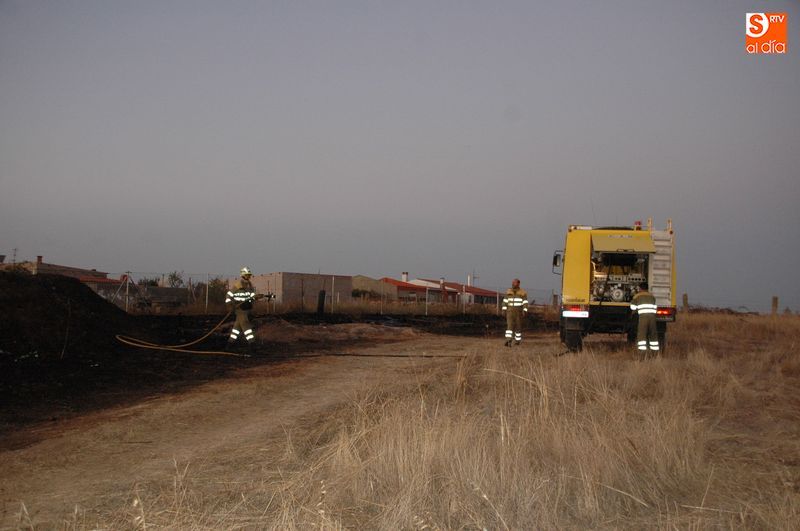
If you had to start over again, would you do anything different?
I’d get more training. Experience covers some gaps, but knowing the theory is essential to speeding up the learning process and putting fires into perspective. I’ve done a lot of self-teaching, I’ve read a lot, but I would have liked to have had more academic training.
Let’s talk about PPE. What do you think of self-protection equipment for extreme situations such as entrapment?
Sometimes we feel unprotected. With some fires, there are unexpected changes in behavior, chaotic situations and fatigue sets in. We don’t work the same after 2 hours of work on an operation as we do after 10 hours when you start getting tunnel vision and everything turns hazy. There is a real risk of entrapment, yet there’s no investment in these kinds of PPE because we just don’t have the budgets. Oftentimes, firefighters don’t even have the basics. Just to give you an example, checkpoint officials in Castilla y León are given construction work helmets to fight wildland fires. Things have gotten better, but there’s still a lot to improve. The bare essentials first have to be covered: helmets, fireproof clothing, boots, goggles and masks. The next step should be personal self-protection (with the Xtreme Shelter and emergency breathing equipment) and collective protection (with fireproof blankets and self-protection nozzles). It wouldn’t do any good to buy them and never upgrade. We need bigger budgets. Another thing that needs more work is training on the different products so squads can learn how to use them properly. That would help prevent risks, increase the life of the products and enhance safety yet there’s hardly any effort on this end.
What type of evolution do you expect to see in the safety sector? Improvements in protection equipment, etc.
I’d like to see garments that help prevent the transfer of heat. Research to discover some type of thermoregulating fiber. Another unresolved matter is respiratory protection. We can’t keep working for 6 hours on a fire with an FFP1 mask. And for situations of greater risk, it’s essential to find some type of system that can supply oxygen without having to carry around an SCBA.
One of the most common causes of death in firefighters in France are traffic accidents that occur because of fatigue after a day of extinguishing. How do you think this risk factor can be eliminated?
To avoid accidents on the way from a fire to base, you need double-cab operatives. Fire trucks in Extremadura are like that with a driver engineer and reserve engineer traveling in each one. This is impossible in Castilla because there are only two of us (in single-cab vehicles). To avoid accidents from base to home, working in the same area as where you live should be a requirement (there’s a lot of seasonality right now with extensive travel).
Generally-speaking, which risk factors should be improved?
Increasing investment in protection equipment. Finding solutions that adapt to each position and getting the people who purchase equipment for brigades to understand these particular needs and keep them in mind. For example, a person in a helitransported unit walks a lot so they need light and comfortable ergonomic boots. A foot injury can put them on the sidelines. When I’m in a fire truck, my feet end up all wet. Maybe we need different solutions.
How do you think the coronavirus crisis will impact fire season?
We really don’t know what we’re going to be facing come fire season. Social distancing solutions are being suggested such as more time on-call than at the base. That decreases exposure, but delays intervention. The future is uncertain, but just as always, we’ll be breaking our backs to rise to whatever challenge comes our way.





